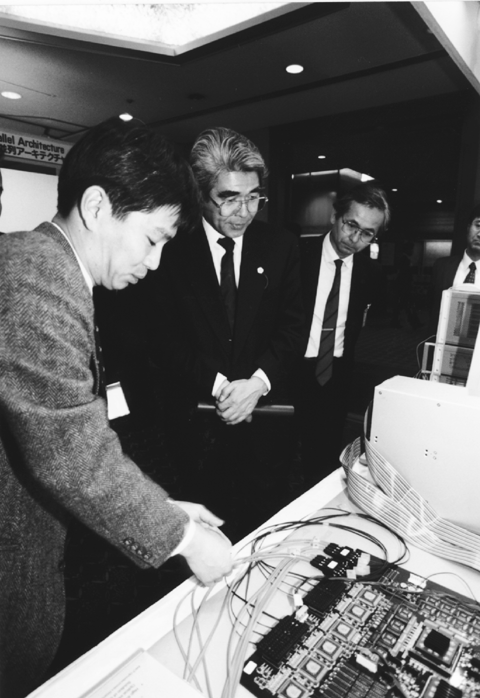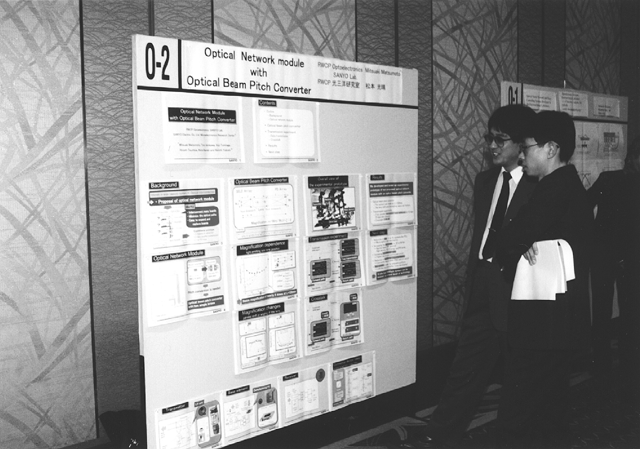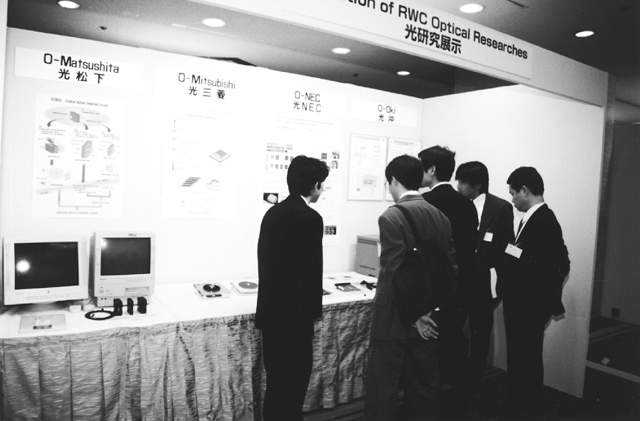
Mr.Nakagawa(center),Director-General of the Machinery and Information Industries Bureau, Optoelectronic Hitachi Lab.
| Toyohiko Yatagai Professor Institute of Applied Physics University of Tsukuba |
Optical technology has made significant advances in the area of communications and memory, but it still remains at an "expectation" stage in the area of information processing. It has been a long time since dreams about optical computing and optical interconnection were first expressed, yet, only recently have studies (those regarding optical interconnection in particular) emerged with practical systems in mind. This is what I felt when I saw the presentations on optical technology in this RWC Symposium.
Sessions regarding optical devices and systems in this Symposium include one demonstration and 14 poster presentations. Specifically, 6 were on optical interconnection, 6 were on optical devices, and 3 were on optical computing. I would like to report on some papers which attracted my attention.
In RWCP, a massively parallel computer with 1,024 interconnected processors, known as RWC-1, is being developed. In this system, the throughput of each processor has reached 10 Gb/s, close to the limit of current wiring technology. To overcome this limitation, optical interconnection are being considered an essential alternative.
The demonstration by the Optoelectronics Hitachi Lab. and the RWCP Tsukuba Research Center showed an optical interconnection system for the RWC-1 test-bed system, which involves the development of transceiver/receiver modules for a 12-channel synchronous parallel optical fiber (single mode) transmission, and an optical interconnection system using those modules. Through the development of laser diode arrays and phototransistor arrays with 12 elements integrated in a 1.3ɠm band, the module throughput of 3 Gb/s and the per-channel throughput of 250 Mb/s have been attained. The test system (SUTB1-H), which uses 8 of the above 12-channel modules, realizes a 48-bit parallel transmission at 100 Mb/s with the overall throughput of 600 MByte/s. The assumed transmission distance is 20 m, which is unattainable with a copper wire interconnection.
The Optoelectronics NEC Lab. made a presentation on the optical interconnection technology for the RWC-1 test-bed system. This system generates throughput in the order of Gb/s by using multimode fiber arrays. The RWC-1 requires a 48-bit parallel interconnection at 100 Mb/s. This system first converts data to 8 bits by 6 channels, encodes this with 8B10B, and then multiplexes 10-bit 6-channel data as 60:6. This arrangement transmits data at 1 Gb/s per channel. This system can perform continuous error-free transmission for 17.5 hours, achieving the BER of 10-14, or less.
As for optical interconnection devices, a surface emitting laser (VCSEL) (Optoelectronics NEC, Optoelectronics Fujitsu, Optoelectronics Furukawa), a vertical transmission optical amplifier (Optoelectronics Toshiba), beam deflector (Optoelectronics Fujikura), and a receiver array (Optoelectronics Sumitomo Elec.) were reported on. VCSEL with oscillation wavelengths of 1.55ɠm (Optoelectronics NEC) and 1.3ɠm (Optoelectronics Fujitsu, Optoelectronics Furukawa) were developed, and micro machine technology made the tuning of the oscillation wavelengths at 35 nm possible by using an external resonator (Optoelectronics Furukawa).

Mr.Nakagawa(center),Director-General of the Machinery and Information Industries Bureau, Optoelectronic Hitachi Lab.
Presentations on optical computing included optical neural computing (ETL, Optoelectronics Mitsubishi), optical fuzzy control (ETL), and parallel digital operation (Optoelectronics Matsushita); the application of optical computing technology has made progress as well. The Optoelectronics Mitsubishi Lab. showed the fabrication of an artificial retina with variable sensitivity photodetection cell array using CMOS technology, and ran an experiment measuring a 3D shape in stereo photographs with a pattern correlation operation using the artificial retina chips.
ETL proposed an operation method where a neuron's coupling weight would not become negative and a method for realizing all-optical learning via the use of a spatial light modulator called PROM. The underlying goal is to achieve all - optical neural computing, and the experimental results were presented. ETL also reported demonstration results regarding stable control of a pendulum with an optical fuzzy operation method, using twin-stripe laser diodes developed by ETL.

Poster presentation by the Optoelectronics Distributed Lab.(Optoelectronics Sanyo Lab.)

Presentation by the Optoelectronics Labs. ar a demonstration booth
In the digital optical computing area, the Optoelectronics Matsushita Lab. developed a system which executes parallel operations by stacking optical fiber image plates into separate or overlay patterns. The Optoelectronics Matsushita Lab. prototyped four pattern duplicators using the implementation of array logic which uses the STOCS system and optical diffractive elements which are components of STOCS.
It has been pointed out that optical computing technology is excellent in parallelism. It may be necessary to promote relatively small-scale experiments to verify the relative principles of optical computing technology and parallelism into larger-scale demonstrative systems.